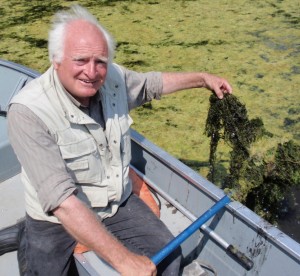Visit our sponsors
MCLA is a regional leader in the prevention of the spread of Aquatic Invasive Species. Actions with several diverse partner organizations include a broad range of educational activities, lake monitoring, lake treatments, and working with boaters to limit infestations.
MCLA Activities—Stopping the spread of Aquatic Invasive Species:
- Conducts bi-annual monitor training sessions on aquatic plant and AIS identification.
- Conducts boat inspections at area lakes to educate boaters on proper techniques to stop AIS.
- Erects and maintains boat cleaning stations at selected lakes.
- Works with the Wisconsin DNR to periodically inventory lake plants in selected waters.
- Works with individual lakes groups to chemically and manually control existing infestations.
- Works on watershed improvements to reduce AIS “blooms”
What are the potential Aquatic Invasive Species threats to Manitowoc County lakes?
To learn more about each threat, click on its name or visit this page.
- Eurasian Water Milfoil (EWM): This plant forms surface mats that interfere with boating and fishing.
- Curly Leaf Pond Weed: This plant forms surface mats that interfere with boating and fishing.
- Purple Loostrife: Disrupts lake ecosystems. Degrades wildlife habitat and blocks recreational waterways.
- Phragmites: This plant invades cattail marshes and critical habitats in flood plain wetlands.
- Quagga and Zebra mussels: Filter and eat good algae, leaving toxic blue green algae. Consume zooplankton, leaving little to be eaten by young fish. Clog intake and distribution pipes of utility plants, costing millions of dollars in control measures.
- Spiny Water Flea: This insect competes with young fish for native zooplankton. Their long spiny tail pierces the stomach of young fish, killing them.
- Banded Mystery Snail: Displace native snail populations. Can carry parasites. Kill largemouth bass embryos. Shells beaches litter beaches.
- Rusty Crayfish: Eat small fish, insects, and fish eggs. Displace native crawfish. Consume more food than native crawfish, destroying underwater habitat and food of native fish populations.
- Japanese Knotweed: Invades wetland areas, crowding out native vegetation and leaving banks vulnerable to erosion when the knotweed drops its leaves in winter. Root system is strong enough to damage pavement and penetrate building foundations.
- Viral Hemorrhagic Septicemia (VHS): This virus first found in the Great Lakes kills more than 25 species of fish, including many popular game fish.
Emerging threat
- Starry Stonewort: This star-shaped submerged annual macroalga is known to cause nuisance conditions in MI, NY and IN. It can outcompete other vegetation and forms monotypic stands that can reduce fish spawning habitat, outcompete other vegetation, and can foul watercraft motors. It has been reported in nearby counties. Update: A new discovery of Starry Stonewort was made in October 2019 in Lake Emery, Marquette County. This is the first verified population outside of the southern region of the state. A rather unique feature is that the Starry Stonewort in Lake Emery has been anecdotally present between 3-6 years. The DNR is currently working with the lake district, as well as surrounding lake districts to assess the population and control options available.
Further reading on AIS and other invasive species currently affecting Manitowoc County
- Kiss your Ash Goodbye by Tom Ward, AIS Coordinator, July 2016
- Invasive Species are Altering the Fisheries of Lake Michigan Jan 2016
- MCLA’s List of Aquatic Invasive Species in Manitowoc County
- Aquatic Invasive Species – Status of Manitowoc County Lakes August 2012
What have we learned from lakefront owners and lake users?
- Lakes with limited access remain free of AIS. This suggests that boaters are the main source of AIS.
- Lakes used by water skiers are among the first to be infested by AIS.
- Lakes adjoining other lakes infested with AIS soon become infested themselves.
Can we do anything about Invasive Species? Yes, we can!
- We can prevent the introduction of AIS into lakes that are not infested. Particular care is needed for those lakes that offer public access. We can set priorities for clean-up of wetland plant sites infested with AIS and act now to control the further spread of AIS into critical habitats.
- What can you do right now to help stop the spread of AIS?
- When visiting our lakes, inspect your equipment, remove any attached plants or animals, drain all water from equipment including live wells and buckets or containers of fish, don’t move live fish or plants away from a waterbody and only buy minnows from a Wisconsin bait dealer. Do not move water, plants or animals from Zebra Mussel infested lakes. Do not travel to different lakes in the same day if possible or disinfect with bleach. Read more on the Wisconsin DNR’s Clean Boats, Clean Waters page.
- When visiting our parks and forests, clean your gear before entering and before you leave. Remove seeds and plant material from shoes and clothing. Clean tires and undercarriage of your ATV or vehicle. Do not move plant or animal material from one location to another. For more ways to prevent the spread of invasive species, visit the Wisconsin Council on Forestry website.


